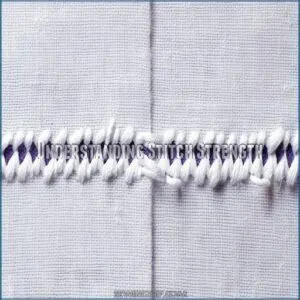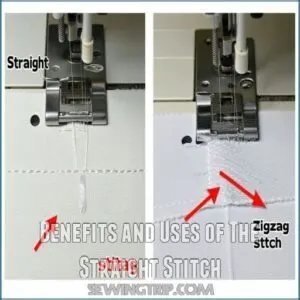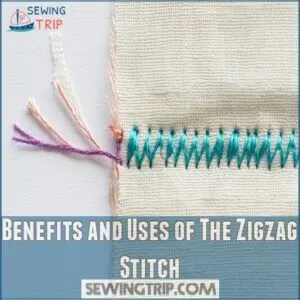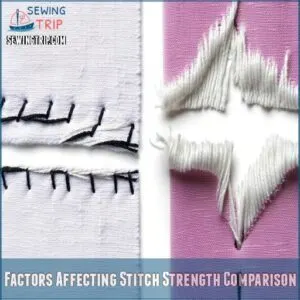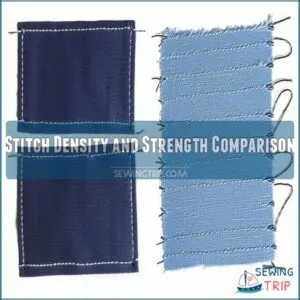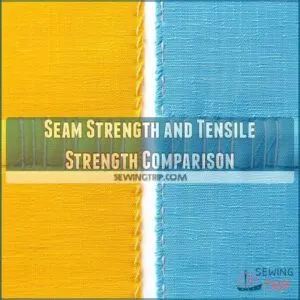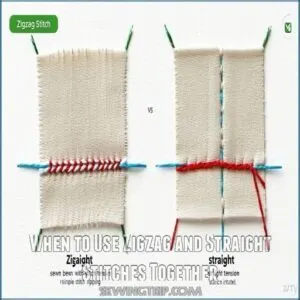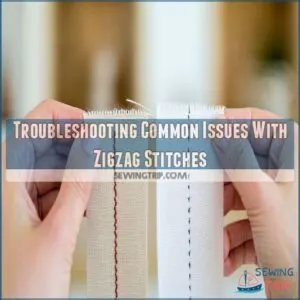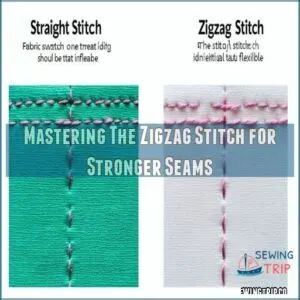This site is supported by our readers. We may earn a commission, at no cost to you, if you purchase through links.
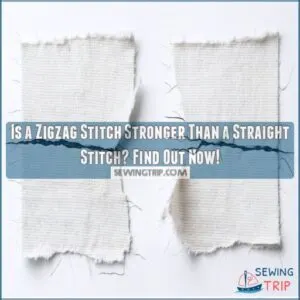 When you wonder whether a zigzag stitch is stronger than a straight one, here’s the stitch story: the straight stitch is like the reliable friend who holds everything together with pure strength. It’s perfect for those sturdy seams on your jeans or that heavy canvas bag.
When you wonder whether a zigzag stitch is stronger than a straight one, here’s the stitch story: the straight stitch is like the reliable friend who holds everything together with pure strength. It’s perfect for those sturdy seams on your jeans or that heavy canvas bag.
Meanwhile, the zigzag stitch excels at flexibility, stretching with fabrics that need a bit of give, like your favorite t-shirt. So, while a zigzag isn’t technically "stronger" in sheer tension, it’s more adaptable, preventing breaks where flexibility is key.
Intrigued by how these stitches can work together for the best of both worlds? Stay tuned!
Table Of Contents
- Key Takeaways
- Understanding Stitch Strength
- Is a Zigzag Stitch Stronger Than a Straight Stitch
- Benefits and Uses of The Straight Stitch
- Benefits and Uses of The Zigzag Stitch
- Comparing The Strength of Zigzag and Straight Stitches
- When to Use Zigzag and Straight Stitches Together
- Troubleshooting Common Issues With Zigzag Stitches
- Mastering The Zigzag Stitch for Stronger Seams
- Frequently Asked Questions (FAQs)
- Conclusion
Key Takeaways
- When you’re deciding between stitches, know that a straight stitch gives you more strength for heavy-duty projects, while a zigzag stitch offers flexibility for stretchy fabrics.
- Use a zigzag stitch when you want to add elasticity and prevent fraying on stretchy materials; it’s perfect for decorative and seam finishes.
- For a durable seam, especially on non-stretch fabrics, go with a straight stitch to ensure strong, stable stitching.
- Combining zigzag and straight stitches can enhance both strength and flexibility, making it ideal for versatile sewing tasks.
Understanding Stitch Strength
When you’re stitching up your next project, understanding stitch strength is super important to achieving durable seams.
The stitch type, along with the thread and fabric you choose, plays a major role in how well your garment holds together.
Factors Affecting Stitch Strength
Stitch strength relies on several key factors. Needle type influences accuracy, while stitch density determines durability.
Both fabric thickness and thread tension play roles in how well a seam holds together. For thicker fabrics, using an upholstery nylon thread, considered the strongest sewing thread, can greatly enhance seam strength.
Adjusting your sewing speed is important too—go too fast, and you might mess things up.
Whether you’re using a zigzag or straight stitch, mastering these elements boosts your sewing mastery.
Role of Thread and Fabric in Stitch Strength
Imagine your stitch as a bridge connecting fabric worlds.
The thread type, like nylon or polyester, and the fabric weight are your trusty cables.
Use sturdy threads for heavier garments; they boost stitch strength and durability.
Meanwhile, fabric type sets the stage—light fabrics demand gentler threads.
Mastering these elements guarantees your zigzag or straight stitch never falters.
Importance of Proper Stitch Selection
So, you’ve got the thread and fabric down?
Great!
Now, picking the right stitch type is key.
Think of it like choosing the right tool for the job.
A straight stitch is your workhorse for strength, while a zigzag stitch adds flexibility.
Matching your stitch type to your project (clothing, canvas, etc.) and fabric type means stronger, better-looking seams every time.
Is a Zigzag Stitch Stronger Than a Straight Stitch
You’re probably wondering whether the zigzag or straight stitch packs more punch in durability.
Well, both have their strengths, but it depends on what you’re stitching.
The straight stitch is renowned for its robust, tight construction, making it formidable for projects like canvaswork and clothing where stitch strength and stitch types for stretch fabrics are key.
For those interested in exploring various zigzag stitch patterns and products, checking out Zigzag Stitch Accessories can be beneficial.
On the other hand, the zigzag stitch shines in versatility.
It offers a flexible seam that stretches with the fabric without losing its grip, ideal for stretchy materials and seam finishing techniques.
Choosing between them isn’t just about stitch skipping solutions but understanding the thread tension impact and the demands of your project.
So, it’s not just about which is stronger—it’s about fitting strengths to the task.
Benefits and Uses of The Straight Stitch
When you’re sewing, the straight stitch is your go-to for strong, reliable seams that stand up to wear and tear.
It’s ideal for most tasks, from joining garment pieces to creating sturdy hems.
Sometimes simple solutions work best.
Qualities of The Straight Stitch
A straight stitch stands strong in your sewing arsenal, marrying durability with subtlety.
Its tight, layered construction makes it resilient against fabric tearing, ensuring minimal stitch visibility.
Think of it as the hidden backbone that doesn’t shout but does the heavy lifting.
As noted in discussions about stitch strength and fabric type, a straight stitch produces a more robust bond for woven materials.
By controlling stitch length and tension, you achieve maximum stitch security and flexibility, ideal for most projects.
Applications of The Straight Stitch in Sewing
When considering sewing stitch types, you’ll see the straight stitch at the heart of many projects.
It’s perfect for seams, hems, and topstitching, thanks to its durability and neatness.
For those looking for specialized tools related to straight stitch uses, exploring online marketplaces like straight stitch products can be beneficial.
Want to create precise lines in quilting?
Stick with the straight stitch.
Tackling buttonholes or binding curves?
Its adaptability makes it a go-to for solid, reliable results.
Advantages of Using The Straight Stitch
Straight stitch holds a charm many new sewers overlook.
Its durability is legendary, ensuring seams stay strong for years.
Here are its perks:
- Versatility: Perfect for most fabrics and projects.
- Seam Strength: Offers unmatched stability.
- Low Visibility: Blends seamlessly.
- Ease of Use: Simple for beginners yet loved by pros.
Embrace its strength and simplicity!
Benefits and Uses of The Zigzag Stitch
You’ll love the zigzag stitch for its versatility, whether you’re serging raw edges or working with stretchy fabrics.
It’s a practical choice for decorative finishes, and you can even use it to mend worn garments with ease—talk about multitasking!
Qualities of The Zigzag Stitch
So, you’ve mastered the straight stitch, huh? Great! Now, let’s talk about its fun, flexible cousin: the zigzag stitch.
It boasts amazing stitch flexibility—perfect for stretchy fabrics.
It’s not just about strength; the zigzag stitch offers impressive decorative potential too.
You can adjust the stitch width for different looks and needs.
This stitch is your secret weapon against fabric tearing prevention, adding a layer of stretch resistance where needed.
Applications of The Zigzag Stitch in Sewing
You’ve got zigzag stitches for sewing stretch fabric, tackling seam finishing, and creating stunning appliqué designs.
By troubleshooting common zigzag stitch problems like uneven stitches and thread breakage through repairing zigzag stitch issues, you can guarantee professional results.
They’re the go-to for decorative hems, effortlessly mending tears while providing solid zigzag stitch strength.
Compared to straight stitch strength, zigzag stitch uses shine in situations needing flexibility and durability.
Think of it as a superhero for versatile stitching tasks!
Advantages of Using The Zigzag Stitch
When you’re dealing with stretch fabric, a zigzag stitch is your trusty sidekick.
It prevents fraying, finishes seams neatly, and opens up creative avenues with design patterns and embellishments.
Unlike a straight stitch, its elasticity offers durability without compromising flexibility.
Plus, it’s perfect for securing fabric edges, making it a versatile choice for sewing projects.
Comparing The Strength of Zigzag and Straight Stitches
When comparing the strength of zigzag and straight stitches, you’ll want to factor in things like stitch density and seam strength.
Think of it this way: just like a strong belt can hold up your pants, picking the right stitch can make all the difference in your sewing project’s durability.
Factors Affecting Stitch Strength Comparison
Understanding stitch strength boils down to several key factors: fabric type, thread type, needle size, and stitch length.
Specifically, the backstitch technique explained in sewing durability offers exceptional durability, especially when used with strong threads like artificial sinew or linen.
Different fabrics, like stretchy types, affect stitch durability.
The right thread and needle combo can make or break your project, so choose wisely.
Stitch length also influences strength; shorter stitches often provide more resilience—critical for strong, long-lasting seams.
Stitch Density and Strength Comparison
Stitch density isn’t just a buzzword; it’s your best friend when comparing zigzag and straight stitches. Here’s why:
- Stitch Length: Longer stitches mean less thread holding pieces together, impacting strength.
- Thread Count: More threads packed into a seam boost durability.
- Fabric Weave: Denser weaves need tighter stitches for the best seam durability.
Keep stitch density in mind for a sturdy project!
Seam Strength and Tensile Strength Comparison
When it comes to sewing, the straight stitch often wins for pure strength due to its unwavering design, resisting seam slippage and enhancing seam durability.
But, stitch length and fabric stretch can tilt the balance.
A zigzag stitch offers flexibility, adapting to fabric movement.
It’s like comparing a sturdy rope to an elastic band—both strong in their arenas.
When to Use Zigzag and Straight Stitches Together
Sometimes, you’ll find that combining a straight stitch’s strength with a zigzag stitch’s flexibility creates the perfect seam, especially when working with tricky fabrics.
Think of it like adding extra support beams to a house – it’s all about building a stronger, more resilient final product!
Combining Stitches for Increased Strength
Pairing zigzag and straight stitches can boost seam strength and durability.
Zigzag adds flexibility, while straight stitches offer solid reinforcement.
Imagine them as a dynamic duo in your sewing toolbox, combining stitch layering and seam reinforcement techniques like double stitching.
It’s like a perfect marriage, blending overlock stitching and binding techniques for enhanced stitch strength and reliability.
Choosing The Right Stitch Combination
When picking the right stitch combo, consider your project’s demands.
A straight stitch offers more strength for seams on non-stretch fabrics, while zigzag excels with elasticity for knits.
Comparing stitch strength and fabric types helps, and you can find more tools to enhance zigzag stitch strength at zigzag stitch products.
Think of sewing like a puzzle: the straight stitch is the reliable edge piece, while zigzag fills the flexible gaps.
Tips for Combining Zigzag and Straight Stitches
Mixing stitches can enhance your sewing project effortlessly. Each stitch has strengths—here’s how to use them together effectively:
- Stitch Strength: Reinforce seams by layering zigzag over straight stitches.
- Fabric Types: Use a zigzag on stretchy fabrics, straight on stable cloth.
- Stitch Sequence: Start with a straight stitch, then zigzag.
- Project Needs: Adapt techniques based on durability and flexibility requirements.
Troubleshooting Common Issues With Zigzag Stitches
When your zigzag stitches start skipping like a record player in a hiccup, don’t worry—you’re not alone.
We’ll walk through some quick fixes, like adjusting tension or swapping out that sneaky bent needle,
so you can keep your sewing projects on track.
Causes of Stitch Skipping and How to Fix It
Encountering stitch skipping? Blame it on a bent needle or mismatched thread tension.
Imagine your sewing machine wrestling with stubborn fabric—enough to make any stitch skip a beat.
Smooth sailing needs sharp needles and proper tension.
Bobbin issues can also cause hiccups.
Maintain your machine and choose the right needle and thread for seamless results every time.
Adjusting Tension and Thread for Optimal Results
Fine-tuning that zigzag stitch is like hitting the sweet spot of a recipe.
Start with proper thread tension by:
- Matching needle type and fabric weight—light fabrics, light needles.
- Adjusting stitch length to suit your fabric; shorter for sturdiness, longer for flexibility.
- Keeping a consistent sewing speed to maintain stitch strength and avoid tension issues.
Common Mistakes to Avoid When Using Zigzag Stitches
Avoiding common zigzag stitch pitfalls is key to success.
Using the wrong needle selection can lead to skipped stitches.
Tension issues? Adjust your machine’s settings carefully.
Don’t yank on your fabric; gentle manipulation prevents puckering.
Remember, thread quality directly impacts stitch strength.
Experiment with stitch length to find the sweet spot for your project.
Happy sewing!
Mastering The Zigzag Stitch for Stronger Seams
Boost the potential of your sewing projects by mastering the zigzag stitch, which offers both strength and flexibility for seams that need a little give.
By choosing the right thread and fabric, you’ll craft durable and eye-catching garments that stretch the limits of standard stitching.
Best Practices for Using The Zigzag Stitch
Zigzag stitches offer more than meets the eye. To make them work best for you:
- Mind the Tension: Keep your zigzag stitch tension balanced to stop puckering.
- Adjust Width and Length: Tailor the zigzag stitch width and length for perfect curves and edges.
- Test First: Always run a test swatch to iron out any kinks.
Tips for Choosing The Right Thread and Fabric
Choosing the right thread and fabric is key.
Think of your zigzag stitch as a dance.
Light fabrics pair with thin threads like a ballet, while heavyweights need sturdy partners.
Match thread thickness and needle size to fabric weight for best tensile strength.
Consider project purpose and stitch type; these choices guarantee sewing stitch durability and reliable seam strength.
Advanced Techniques for Using The Zigzag Stitch
When you’re mastering the zigzag stitch, think of it as adding a touch of finesse to your project.
Try using zigzag stitch variations to tackle stretch fabrics effortlessly and enhance sewing stitch durability.
Experiment with decorative uses for an artistic flair.
Troubleshoot any hiccups by adjusting tension and remember, it’s perfect for preventing fraying along fabric edges.
Frequently Asked Questions (FAQs)
Is a zig-zag stitch stronger than a straight stitch?
Remember the myth of Theseus’s thread?
A straight stitch is typically stronger than a zigzag.
Its tight weave creates a more durable bond, perfect for heavy-duty projects.
Zigzag excels in stretch and flexibility.
What is the difference between Zig Zag stitching and satin stitching?
Zigzag stitching moves side-to-side, providing flexibility and decoration; you often use it for stretch fabrics.
Satin stitching, a dense, close zigzag, is ideal for decorative edges and appliqué, offering a smooth, glossy finish on fabrics.
Is Zig Zag a good stitch?
Irony aside, the zigzag stitch excels at flexibility and decorative flair, perfect for stretchy fabrics and seam finishes.
It’s not the strongest stitch, but its versatility makes it invaluable for adding style and function to projects.
Do zigzag stitches look good on thin fabric?
On thin fabric, zigzag stitches can add a playful twist but might cause puckering if tension isn’t just right.
For a neat finish, test on scraps first to fine-tune your machine’s settings.
What is a narrow zig zag stitch?
It’s not rocket science: a narrow zigzag stitch features a close-set stitch with a tiny side-to-side pattern.
It is ideal for reinforcing seams, sewing elastic, or creating decorative finishes on delicate fabrics without overwhelming their texture.
How to do zigzag pattern stitch?
To do a zigzag pattern stitch, set your sewing machine to zigzag mode.
Adjust the stitch width and length to your preference.
Place the fabric under the presser foot and stitch steadily, ensuring fabric alignment.
Are zig zag or straight stitches stronger?
Straight stitches generally win the strength contest. They’re tightly layered, creating a super strong bond. Zigzag stitches are great for stretch, but straight stitches are the champs for pure strength.
Which sewing stitch is the strongest?
The straight stitch is the strongest sewing stitch due to its tight, layered construction, creating a robust bond.
Ideal for stable fabrics and reinforcing seams, it outshines other stitches in strength, making it perfect for durable projects.
What are the benefits of zigzag stitch?
Think of the zigzag stitch as a toolbox’s multitool.
It prevents fraying, adds stretch, and decorates seams.
Perfect for hemming, repairing, or sewing stretchy fabrics, it’s your versatile ally in creating durable, stylish projects.
What are the disadvantages of zigzag stitches?
You might find zigzag stitches challenging with delicate fabrics as they can cause puckering.
They’re also less neat than straight stitches.
Stitch skipping can be frequent if tension isn’t right, complicating intricate projects.
Conclusion
Choosing between a zigzag stitch and a straight stitch depends on your sewing project needs.
A straight stitch offers solid strength, perfect for sturdy, non-stretch fabrics, while a zigzag stitch shines in flexibility, making it ideal for stretchy materials.
By understanding the strengths and applications of each, you can make an informed decision for your project.
So, is a zigzag stitch stronger than a straight stitch? Not necessarily, but it provides important adaptability where needed.

